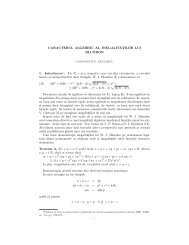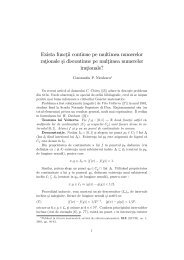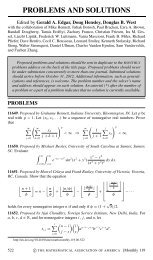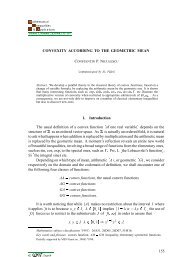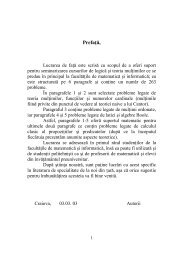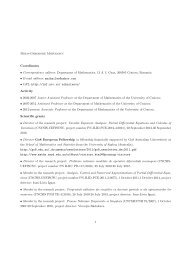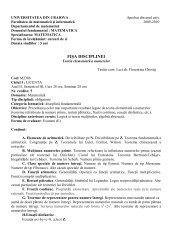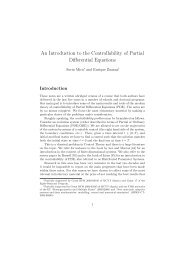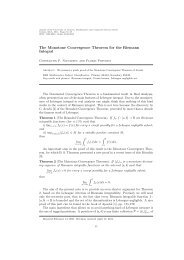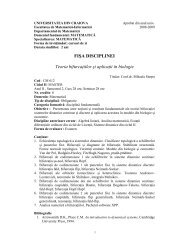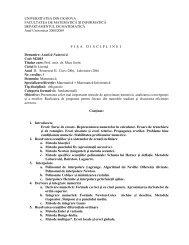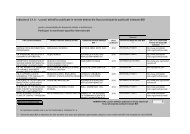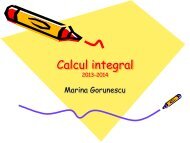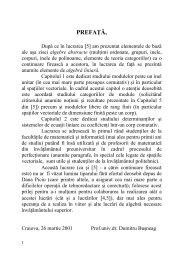A NOTE ON STIRLING'S FORMULA FOR THE GAMMA FUNCTION ...
A NOTE ON STIRLING'S FORMULA FOR THE GAMMA FUNCTION ...
A NOTE ON STIRLING'S FORMULA FOR THE GAMMA FUNCTION ...
You also want an ePaper? Increase the reach of your titles
YUMPU automatically turns print PDFs into web optimized ePapers that Google loves.
Journal of Prime Research in Mathematics Vol. 8(2012), 01-04<br />
A <strong>NOTE</strong> <strong>ON</strong> STIRLING’S <strong><strong>FOR</strong>MULA</strong> <strong>FOR</strong> <strong>THE</strong> <strong>GAMMA</strong><br />
FUNCTI<strong>ON</strong><br />
DORIN ERVIN DUTKAY 1 , C<strong>ON</strong>STANTIN P. NICULESCU 2 , FLORIN POPOVICI 3<br />
Abstract. We present a new short proof of Stirling’s formula for the<br />
Gamma function. Our approach is based on the Gauss product formula<br />
and on a remark concerning the existence of horizontal asymptotes.<br />
Key words: mean value theorem, Stirling’s formula, Gosper’s formula.<br />
AMS subject: Primary 26A51. Secondary 26A48.<br />
Stirling’s formula is an approximation for large factorials, precisely,<br />
n! ≈ √ 2πn n+1/2 e −n (S)<br />
in the sense that the ratio of the two sides tends to 1 as n → ∞. This<br />
formula was discovered by Abraham de Moivre as part of his contribution to<br />
the normal approximation for the binomial distribution. His first derivation<br />
did not explicitly determine the constant √ 2π but in a 1731 addendum he<br />
acknowledged that James Stirling was able to determine the constant, using<br />
Wallis’ formula.<br />
The literature concerning Stirling’s formula is very large, counting hundreds<br />
of items on JSTOR. See for example [2], [3], [7], [8], [9] and [11].<br />
The problem of extending the factorial to non-integer arguments was solved<br />
by Euler in 1729, by introducing the Gamma function via an infinite product,<br />
rewritten by Gauss under the form<br />
n!n x<br />
Γ(x) = lim<br />
, x > 0. (Γ)<br />
n→∞ x(x + 1) · · · (x + n)<br />
1 Department of Mathematics, University of Central Florida, Orlando, USA. Email:<br />
ddutkay@gmail.com.<br />
2 Department of Mathematics, University of Craiova, Craiova, Romania. Email:<br />
cniculescu47@yahoo.com.<br />
3 College Grigore Moisil, Braşov, Romania. Email: popovici.florin@yahoo.com.<br />
1
2 Dorin Ervin Dutkay, Constantin P. Niculescu, Florin Popovici<br />
In January 1730, Euler announced the integral representation of this function,<br />
Γ(x) =<br />
∫ 1<br />
0<br />
(− ln s) x ds,<br />
which, via the change of variable t = ln s, becomes the familiar Euler integral,<br />
Γ(x) =<br />
∫ ∞<br />
0<br />
t x−1 e −t dt for x > 0,<br />
Stirling’s formula has a companion for the Gamma function,<br />
Γ(x + 1) ≈ √ 2πx x+1/2 e −x as x → ∞, (SL)<br />
first noticed by Pierre-Simon Laplace [6].<br />
The aim of our note is to provide a short proof of the formula (SL), based<br />
on Euler’s initial definition of the Gamma function and the following remark<br />
concerning the existence of horizontal asymptotes:<br />
Lemma 1. Suppose that (a n ) n is an increasing sequence of positive real numbers<br />
such that sup a n = ∞ and sup (a n+1 − a n ) < ∞, and F : [0, ∞) → R is a<br />
differentiable function such that lim n→∞ F (a n ) = l and lim x→∞ F ′ (x) = 0.<br />
Then lim x→∞ F (x) = l.<br />
Proof. According to our hypotheses, for ε > 0 arbitrarily fixed there is δ > 0<br />
such that |F ′ (x)| ≤ ε whenever x ≥ δ. Choose an index N such that a N ≥<br />
δ. Since every x ≥ a N lies in an suitable interval [a n , a n+1 ), an appeal to<br />
Lagrange’s Mean Value Theorem yields<br />
whence lim x→∞ F (x) = l.<br />
|F (x) − l| ≤ |F (x) − F (a n )| + |F (a n ) − l|<br />
≤ ε sup (a n+1 − a n ) + |F (a n ) − l| ,<br />
n<br />
Our proof of the formula (SL) makes use of the auxiliary function<br />
( )<br />
Γ(x + 1)e<br />
x<br />
F (x) = ln<br />
x x+1/2 , x > 0.<br />
According to Stirling’s formula, lim n→∞ F (n) = ln (√ 2π ) , and thus Lemma<br />
1 reduces the proof of (SL) to the fact that lim x→∞ F ′ (x) = 0. This can be<br />
done by noticing the Weierstrass product formula,<br />
Γ(x) = lim<br />
n→∞<br />
= 1 x lim<br />
n→∞<br />
= 1 x e−γx ∏ ∞<br />
n!n x<br />
x(x + 1) · · · (x + n) = 1 x lim<br />
n→∞<br />
(<br />
1 +<br />
x<br />
1<br />
ex(ln n−1−1/2−···−1/n) ex+x/2+···+x/n<br />
n=1<br />
(<br />
1 +<br />
x<br />
1<br />
)<br />
· · ·<br />
(<br />
1 +<br />
x<br />
n<br />
)<br />
e x ln n<br />
)<br />
· · ·<br />
(<br />
1 +<br />
x<br />
n<br />
(<br />
1 + x n) −1<br />
e x/n , (W )<br />
)<br />
□
A note on Stirling’s formula for the Gamma function 3<br />
(∑<br />
where γ = lim n<br />
n→∞ k=1 1 k − ln n) is Euler’s constant. By taking the logarithm<br />
of both sides of the formula (W ) we obtain<br />
ln Γ(x) = − ln x − γx + ∑ ∞<br />
( x<br />
(<br />
n=1 n − ln 1 + x ))<br />
,<br />
n<br />
whence<br />
Γ ′ (x)<br />
Γ(x) = − 1 x − γ + ∑ ∞<br />
= −γ + ∑ ∞<br />
n=1<br />
( 1<br />
n=1 n − 1 )<br />
x + n<br />
( 1<br />
n − 1<br />
x + n − 1<br />
)<br />
. (DS)<br />
Here we applied the classical theorem on term by term differentiation, which<br />
asks for the local uniform convergence of the series of derivatives. See Thomson,<br />
Bruckner and Bruckner [10], Corollary 9.35, p. 579. This convergence follows<br />
from the Weierstrass M-test because on every interval (0, R] with R > 0,<br />
the general term of the series (DS) verifies<br />
1<br />
∣n − 1<br />
x + n∣ ≤ R for x ∈ (0, R],<br />
n2 and the series ∑ n≥1 1 n 2 is convergent.<br />
Therefore<br />
F ′ (x) = Γ′ (x + 1)<br />
Γ(x + 1) − ln x − 1<br />
2x<br />
= −γ − 1<br />
x + 1 + ∑ ∞<br />
n=1<br />
= lim<br />
n→∞<br />
Taking into account that<br />
(<br />
ln n x − ∑ n<br />
ln(x + 2 + k) − ln(x + 1 + k) <<br />
we obtain that<br />
k=0<br />
( 1<br />
n − 1<br />
x + n<br />
1<br />
x + k + 1<br />
)<br />
− ln x − 1<br />
2x<br />
)<br />
− 1<br />
2x .<br />
1<br />
< ln(x + 1 + k) − ln(x + k)<br />
x + k + 1<br />
− 1<br />
2x ≤ F ′ (x) ≤ ln x + 1 − 1<br />
x 2x ,<br />
whence lim x→∞ (ln F (x)) ′ = 0. The proof of the formula (SL) is done.<br />
Gosper’s algorithm [4] for acceleration the rate of convergence of series yields<br />
a better approximation to n!, precisely,<br />
√ (<br />
n! ≈ 2n + 1 πn<br />
3)<br />
n e −n .
4 Dorin Ervin Dutkay, Constantin P. Niculescu, Florin Popovici<br />
The same argument as above allows us to conclude that<br />
√ (<br />
Γ(x + 1) ≈ 2x + 1 πx<br />
3)<br />
x e −x .<br />
References<br />
[1] H. Alzer, On Ramanujan’s Double Inequality for the Gamma Function, Bulletin London<br />
Mathematical Society, 35 (2003) Issue 5, 601-607.<br />
[2] P. Diaconis and D. Freedman, An Elementary Proof of Stirling’s Formula, American<br />
Mathematical Monthly 93 (1986), No. 2, 123-125.<br />
[3] D. E. Dutkay, C. P. Niculescu and F. Popovici, A Short Proof of Stirling’s Formula. To<br />
appear in American Mathematical Monthly.<br />
[4] R. W. Gosper, Decision procedure for indefinite hypergeometric summation, Proc. Natl.<br />
Acad. Sci. USA, 75 (1978), 40–42.<br />
[5] E. A. Karatsuba, On the asymptotic representation of the Euler gamma function by<br />
Ramanujan, J. Comp. Appl. Math. 135 (2001), 225–240<br />
[6] P. S. Laplace, Mémoire sur la probabilité des causes par les événements. Memoires de<br />
mathématique et de Physique Presentés a I’Académie Royale des Sciences, par divers<br />
savants, et lus dans ses Assemblées, 6, 1774, Paris. (Reprinted in Laplace’s Oeuvres<br />
Complètes, vol. 8, pp. 27-65. English translation by S. Stigler, Technical Report #164,<br />
Department of Statistics, University of Chicago, September, 1984.)<br />
[7] Yuan-Chuan Li, A note on an identity of the gamma function and Stirling’s formula,<br />
Real Analysis Exchange 32 (2006) No.1, 267–272.<br />
[8] V. Namias, A Simple Derivation of Stirling’s Asymptotic Series, American Mathematical<br />
Monthly 93 (1986), No. 1, 25-29.<br />
[9] J. M. Patin, A Very Short Proof of Stirling’s Formula, American Mathematical Monthly<br />
96 (1989), No. 1, 41-42.<br />
[10] B. S. Thomson, A. M. Bruckner and J. Bruckner, Elementary Real Analysis, 2nd Ed.,<br />
2008. Available at http://classicalrealanalysis.com<br />
[11] I. Tweddle, Approximating n!. Historical origins and error analysis, Amer. J. Phys. 52<br />
(1984) 487.



